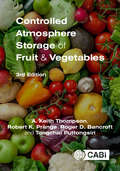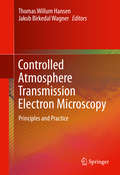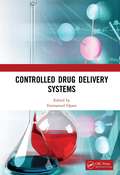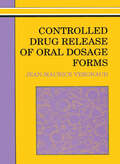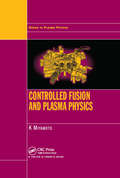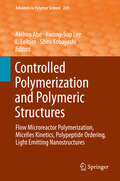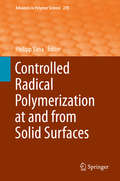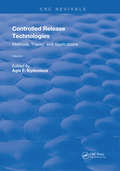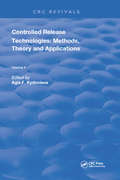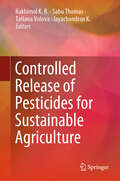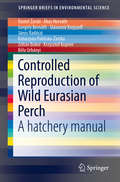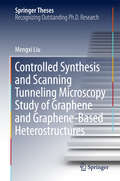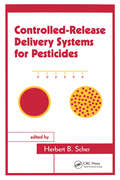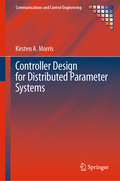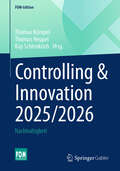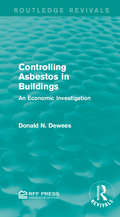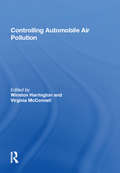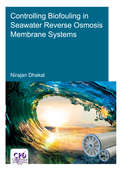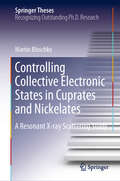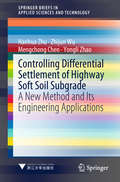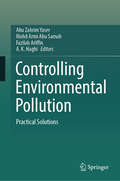- Table View
- List View
Controlled Atmosphere Storage of Fruit and Vegetables
by A Thompson Robert K. Prange Dr Roger Bancroft Tongchai PuttongsiriThe third edition of this successful title presents current research and commercial uses of controlled atmosphere storage and modified atmosphere packaging of fresh fruit and vegetables to provide a comprehensive and up-to-date overview. New and developed technologies for the transportation and storage of horticultural products are essential to ensure that produce reaches consumers in the best possible condition, and have the potential to reduce the postharvest use of chemicals, reduce losses and maintain nutritional quality and organoleptic characteristics. Covering the increasingly used science and technology of preserving the freshness of fruit and vegetables in all aspects of their postharvest life, this book puts the subject in the context of its history and current practices, in addition to future prospects. The new edition: - Explores the large volume of research that is continuously being published on the topic. - Reviews and evaluates the adaptation and improvement of commercial technologies. - Considers the effects of techniques and technologies on flavour, quality and physiology, in addition to the damage inflicted by pests, diseases and disorders. - Contains 5 new chapters covering genetics and CA storage, dynamic CA storage, hyperbaric storage, hypobaric storage and fruit ripening. Fully revised and presented in full colour throughout, this book is a readily accessible resource for researchers, scientists, growers, students and industry personnel.
Controlled Atmosphere Transmission Electron Microscopy: Principles and Practice
by Thomas Willum Hansen Jakob Birkedal WagnerThis book illustrates the practical workings of environmental transmission electron microscopy (ETEM) from history and instrument design through to solving practical problems. Aspects of instrument design, performance, and operating procedures are covered, together with common problems and pitfalls of the technique. Not only will a properly operated instrument and a carefully set up experiment provide new insight into your specimen, but the ability to observe the specimen in its natural habitat will be essential to meeting specific design criteria for the development of the next generation of materials. Over the past five decades, transmission electron microscopy (TEM) under environmental conditions relevant to a particular sample has been of increasing interest. Symposia dealing with the topic are now among the best attended at international microscopy conferences. Since typical operating modes for the ETEM require the sample be subjected to a harsh environment consisting of corrosive gases and high temperatures, the challenges of adapting and operating the instrument for observation under dynamic operating conditions are numerous. However, careful consideration of the interaction of the electrons with the gases and sample, as well as the gases with the microscope components, can lead to highly rewarding results. In Controlled Atmosphere Transmission Electron Microscopy, leading experts help you to perform successful experiments using the ETEM, and to interpret and understand the results.
Controlled Drug Delivery Systems
by Emmanuel OparaThis book will describe current research on drug delivery systems that encompass four broad categories, namely: routes of delivery, delivery vehicles, payload, and targeting strategies. Where appropriate delivery vehicles and relevant release of specific agents in any of these categories in clinical application will be discussed. All chapters will highlight the translational aspects of the various technologies discussed and will provide insights into the advantages of such delivery systems over current ones in clinical or research use. Each technology reviewed in this book will have significant potential to improve patients' lives by enhancing the therapeutic efficacy of drugs. This book: Discusses the various factors that mitigate effective oral insulin delivery and the current status of research efforts to overcome these barriers along with recent clinical projections Examines the advantages and disadvantages of each drug delivery system Examines the standard method of accomplishing controlled drug release through the incorporation of the drugs within polymeric biomaterials such as capsules and microcapsules as well as other vehicles such as liposomes Discusses various controlled drug delivery systems, including sustained release delivery systems and pulse or delayed release, e.g. to target different regions of the gastrointestinal tract. In view of these wide-ranging technological areas, and the up-to-date discussions of opportunities and challenges associated with these applications, the book should provide readers from technology, materials science, pharmacology and clinical disciplines with very valuable information.
Controlled Drug Release Of Oral Dosage Forms
by Jean-Maurice VergnaudNumerical analysis of matter transfer is an area that pharmacists find difficult, but which is a technique frequently used in preparing controlled drug release and oral dosage forms. A practical guide which explains how to carry out the numerical analysis of matter transfer - a vital process when examining the formulation of oral dosage forms with controlled drug release. The author models the process of drug delivery using numerical analysis and computerization.
Controlled Environment Horticulture: Improving Quality of Vegetables and Medicinal Plants
by Christoph-Martin GeilfusAn understanding of crop physiology and ecophysiology enables the horticulturist to manipulate a plant’s metabolism towards the production of compounds that are beneficial for human health when that plant is part of the diet or the source of phytopharmaceutical compounds. The first part of the book introduces the concept of Controlled Environment Horticulture as a horticultural production technique used to maximize yields via the optimization of access to growing factors. The second part describes the use of this production technique in order to induce stress responses in the plant via the modulation of these growing factors and, importantly, the way that this manipulation induces defence reactions in the plant resulting in the production of compounds beneficial for human health. The third part provides guidance for the implementation of this knowledge in horticultural production.
Controlled Fusion and Plasma Physics
by Kenro MiyamotoResulting from ongoing, international research into fusion processes, the International Tokamak Experimental Reactor (ITER) is a major step in the quest for a new energy source.The first graduate-level text to cover the details of ITER, Controlled Fusion and Plasma Physics introduces various aspects and issues of recent fusion research activ
Controlled Polymerization and Polymeric Structures: Flow Microreactor Polymerization, Micelles Kinetics, Polypeptide Ordering, Light Emitting Nanostructures (Advances in Polymer Science #259)
by Akihiro Abe Kwang-Sup Lee L. Leibler Shiro KobayashiAdvances in Polymer Science enjoys a longstanding tradition and good reputation in its community. Each volume is dedicated to a current topic, and each review critically surveys one aspect of that topic, to place it within the context of the volume. The volumes typically summarize the significant developments of the last 5 to 10 years and discuss them critically, presenting selected examples, explaining and illustrating the important principles, and bringing together many important references of primary literature. On that basis, future research directions in the area can be discussed. Advances in Polymer Science volumes thus are important references for every polymer scientist, as well as for other scientists interested in polymer science - as an introduction to a neighboring field, or as a compilation of detailed information for the specialist.
Controlled Radical Polymerization at and from Solid Surfaces (Advances in Polymer Science #270)
by Philipp VanaThe series Advances in Polymer Science presents critical reviews of the present and future trends in polymer and biopolymer science. It covers all areas of research in polymer and biopolymer science including chemistry, physical chemistry, physics, material science. The thematic volumes are addressed to scientists, whether at universities or in industry, who wish to keep abreast of the important advances in the covered topics. Advances in Polymer Science enjoys a longstanding tradition and good reputation in its community. Each volume is dedicated to a current topic, and each review critically surveys one aspect of that topic, to place it within the context of the volume. The volumes typically summarize the significant developments of the last 5 to 10 years and discuss them critically, presenting selected examples, explaining and illustrating the important principles, and bringing together many important references of primary literature. On that basis, future research directions in the area can be discussed. Advances in Polymer Science volumes thus are important references for every polymer scientist, as well as for other scientists interested in polymer science - as an introduction to a neighboring field, or as a compilation of detailed information for the specialist. Review articles for the individual volumes are invited by the volume editors. Single contributions can be specially commissioned. Readership: Polymer scientists, or scientists in related fields interested in polymer and biopolymer science, at universities or in industry, graduate students
Controlled Release Pesticides Formulations
by Nathan F. CardarelliThe main goal of this book is to present a summary of the state of the art historical background. Conventional chemical pest control methods are mentioned only as a means of comparison to controlled release. Research endeavour with biological weapons, potential usage of such controls, and the few instances of success are likewise brought into focus with the same motive. Formulations and methods or preparing controlled release pesticides are discussed in some detail as concerns the antifouling and molluscicide areas, where the compounding methodology has been well developed. The mathematical basis of controlled release has been developed to an extent and is presented in an abbreviated form.
Controlled Release Technologies: Methods, Theory, and Applications (Routledge Revivals #1)
by Agis F. KydonieusFirst Published in 1985, this book offers comprehensive insight into the process of administering chemical ingredients. Carefully compiled and filled with a vast repertoire of notes, diagrams, and references this book serves as a useful reference for students of pharmacology and other practitioners in their respective fields.
Controlled Release Technologies: Methods, Theory, and Applications (Routledge Revivals #2)
by Agis F. KydonieusFirst Published in 1985, this book offers comprehensive insight into the process of administering chemical ingredients. Carefully compiled and filled with a vast repertoire of notes, diagrams, and references this book serves as a useful reference for students of pharmacology and other practitioners in their respective fields.
Controlled Release of Pesticides for Sustainable Agriculture
by Sabu Thomas Rakhimol K. R. Tatiana Volova Jayachandran K.This book presents an introduction to the concept and need of sustainable agriculture, the mechanisms of conventional and controlled release of pesticides, herbicides and plant hormones. It also contains the carriers which supply controlled release including polymers and nanoparticles. A full chapter is devoted to the theory and simulation aspects.
Controlled Reproduction of Wild Eurasian Perch: A hatchery manual (SpringerBriefs in Environmental Science)
by Daniel Żarski Ákos Horváth Gergely Bernáth Sławomir Krejszeff János Radóczi Katarzyna Palińska-Żarska Zoltán Bokor Krzysztof Kupren Béla UrbányiThe work summarizes the current knowledge regarding the controlled reproduction of an emerging aquaculture species, the Eurasian perch (Perca fluviatilis). In great detail it describes and explains the principal of most of the controlled reproductive protocol leading to obtain high quality larvae. The book is primarily intended to be used as a hatchery manual by practicing aquaculturists and laboratory technicians working with this species. On the other hand, it also summarizes the scientific background of the methods applied, therefore, it can serve as a reference for the state-of-the-art in the controlled reproduction of Eurasian perch and other freshwater percid species.
Controlled Surface Wetting: From Bioinspiration to Applications
by Yongmei ZhengComprehensive resource covering the latest development of surface engineering inspired by nature with a special focus on wetting control Drawing from the natural abilities of plants and animals around the world, Controlled Surface Wetting takes a deep dive into wetting-controlled systems of biological surfaces with information on mechanisms, theory, surface design, fabrication, and effects. This book guides readers to design better engineering surfaces for applications in self-cleaning, water harvesting and repellency, anti-icing, liquid-transport, and beyond. Exploring the latest literature, this book introduces bioinspired techniques and methods to design wetting-controlled surfaces by using organic or inorganic materials, including those with high/low surface energy, regular/irregular, ordered/disordered, or rough/smooth surfaces, or endless arrangements and combinations of micro- and nanostructures of various styles. This book begins by introducing biological surfaces such as plant leaves and duck feathers, butterfly wings, and spider silks, as well as their functions, including superhydrophobic properties, water repellency, and capturing tiny water droplets, respectively, progressing through to more advanced topics such as dually-mobile super-repellency, multi-liquid repellency, and switchable repellency in both air and liquid. Controlled Surface Wetting includes discussion on: Fundamental wetting theories, extension and theoretical models, wetting dynamics and kinetics, physics of wetting, wetting adhesion, and wetting chemistry Static and dynamic gradients, texture gradients such as gradient polymers, wedge- and helical-induced gradients, and synergism of multi-gradients Formation, control, and instability of Rayleigh instability, microfluidics, fluid-coating, electrospinning, fluid diffusion, and laser techniques Coalesced-droplet vertical transport, the hierarchical droplet size-effect, atmospheric water harvesting, and energy harvesting Artificial skins and sensors, including artificial skin vision, and medical applications, including directional-controllable drug delivery Controlled Surface Wetting is an up-to-date and completely comprehensive resource for students and researchers in chemistry, physics, and materials science seeking to learn about the design of smart and advanced materials for engineering applications.
Controlled Synthesis and Scanning Tunneling Microscopy Study of Graphene and Graphene-Based Heterostructures (Springer Theses)
by Mengxi LiuThis thesis focuses on the energy band engineering of graphene. It presents pioneering findings on the controlled growth of graphene and graphene-based heterostructures, as well as scanning tunneling microscopy/scanning tunneling spectroscopy (STM/STS) studies on their electronic structures. The thesis primarily investigates two classes of graphene-based systems: (i) twisted bilayer graphene, which was synthesized on Rh substrates and manifests van Hove singularities near Fermi Level, and (ii) in-plane h-BN-G heterostructures, which were controllably synthesized in an ultrahigh vacuum chamber and demonstrate intriguing electronic properties on the interface. In short, the thesis offers revealing insights into the energy band engineering of graphene-based nanomaterials, which will greatly facilitate future graphene applications.
Controlled-Release Delivery Systems for Pesticides
by Herbert B. ScherHighlighting means of reducing toxicity, increasing efficacy, lessening environmental impact, and facilitating product development, this work covers up-to-date advances in pesticide delivery technologies. It evaluates pesticide formulations and their use in mixtures that reduce physical incompatibilities in spray tanks and biological anatagonism in the field.
Controller Design for Distributed Parameter Systems (Communications and Control Engineering)
by Kirsten A. MorrisThis book addresses controller and estimator design for systems that vary both spatially and in time: systems like fluid flow, acoustic noise and flexible structures. It includes coverage of the selection and placement of actuators and sensors for such distributed-parameter systems. The models for distributed parameter systems are coupled ordinary/partial differential equations. Approximations to the governing equations, often of very high order, are required and this complicates both controller design and optimization of the hardware locations. Control system and estimator performance depends not only on the controller/estimator design but also on the location of the hardware. In helping the reader choose the best location for actuators and sensors, the analysis provided in this book is crucial because neither intuition nor trial-and-error is foolproof, especially where multiple sensors and actuators are required, and moving hardware can be difficult and costly. The mechatronic approach advocated, in which controller design is integrated with actuator location, can lead to better performance without increased cost. Similarly, better estimation can be obtained with carefully placed sensors. The text shows how proper hardware placement varies depending on whether, disturbances are present, whether the response should be reduced to an initial condition or whether controllability and/or observability have to be optimized. This book is aimed at non-specialists interested in learning controller design for distributed-parameter systems and the material presented has been used for student teaching. The relevant basic systems theory is presented and followed by a description of controller synthesis using lumped approximations. Numerical algorithms useful for efficient implementation in real engineering systems and practical computational challenges are also described and discussed.
Controlling & Innovation 2025/2026: Nachhaltigkeit (FOM-Edition)
by Thomas Kümpel Thomas Heupel Kay SchlenkrichDieses Buch zeigt die aktuellen Entwicklungen und deren Auswirkungen auf das Controlling auf. Das Controlling als Informationslieferant im Rahmen des Planungs-, Steuerungs- und Kontrollprozesses muss auf diese Entwicklungen schnell und effizient reagieren. Dies gilt sowohl für das operative als auch für das strategische Controlling. Das Themenfeld der Nachhaltigkeit steht im Fokus der Betrachtung. Die unter dem Begriff der Nachhaltigkeit zusammengefassten Phänomene und Herausforderungen verändern unsere gesellschaftlichen, ökonomischen und biologischen Systeme und Strukturen in bisher nie dagewesener Weise. Für Controllerinnen und Controller, die unter dem Ansatz der Rationalitätssicherung zielgerichtetes Handeln fördern und steuern wollen, ist die Nachhaltigkeit damit vielleicht die größte Herausforderung, der sich das moderne Controlling bisher stellen muss. Damit steht das Controlling als Disziplin, die sich des Nachhaltigkeitsthemas annimmt, sicher nicht alleine da. Aber vielleicht ist es gerade das Verständnis von Controlling, das im Umgang mit diesen Herausforderungen eine Schlüsselrolle einnimmt. Die zielgerichtete, rationale und evidenzbasierte Vorgehensweise, der sich Controllerinnen und Controller verschrieben haben, ist keineswegs eine Garantie dafür, die aktuellen und noch vor uns liegenden Herausforderungen zu lösen. Aber es ist die einzige Vorgehensweise, die hierzu überhaupt in der Lage ist.
Controlling Asbestos in Buildings: An Economic Investigation (Routledge Revivals)
by Donald N. DeweesAsbestos dust is well-known for causing cancer and other life-threatening illnesses yet still contaminates countless schools, factories and office buildings. This raises the issue of the best way to deal with Asbestos; immediate removal, containment or removal at renovation or demolition. Originally published in 1986, this report aims to evaluate these methods of dealing with asbestos in relation to their cost-effectiveness to conclude the most appropriate solution. This title will be of interest to students of Environmental Studies and Economics.
Controlling Automobile Air Pollution (The\international Library Of Environmental Economics And Policy Ser.)
by Virginia McConnellThis volume includes many of the most influential and interesting academic articles related to the economics of mobile source pollution control. The papers included explore why vehicles and vehicle markets are unique, provide estimates of the type and magnitude of the social costs of driving and examine estimation methods and estimates of the various elasticities of vehicle demand. Analysis of the social costs and policies to reduce both traditional air pollutants and greenhouse gas emissions are included. Selected articles review the range of evaluation of both regulatory and market-based approaches to controlling emissions. The complexity of the effects of different policies are emphasized and the unintended consequences of regulation are explored in the context of vehicle emissions reduction policies.
Controlling Biofouling in Seawater Reverse Osmosis Membrane Systems (IHE Delft PhD Thesis Series)
by Nirajan DhakalSeawater desalination is a rapidly growing coastal industry that is increasingly threatened by algal blooms. Depending on the severity of algal blooms, desalination systems may be forced to shut down because of clogging and/or poor feed water quality. To maintain stable operation and provide good feed water quality to seawater reverse osmosis (SWRO) systems, ultrafiltration (UF) pre-treatment is proposed.This research focused on assessing the ability of UF and other pre-treatment technologies to reduce biofouling in SWRO systems. An improved method to measure bacterial regrowth potential (BRP) was developed and applied at laboratory, pilot and full scale to assess the ability of conventional UF (150 kDa) and tight UF (10 kDa) alone and in combination with a phosphate adsorbent to reduce regrowth potential and delay the onset of biofouling in SWRO.The improved bacterial regrowth potential method employs a natural consortium of marine bacteria as inoculum and flow cytometry. The limit of detection of the BRP method was lowered to 43,000 ± 12,000 cells/mL, which is equivalent to 9.3 ± 2.6 µg-Cglucose/L.The reduction in bacterial regrowth potential after tight UF (10 kDa) was 3 to 4 times higher than with conventional UF (150 kDa). It was further reduced after the application of a phosphate adsorbent, independent of pore size of the UF membrane. Pilot studies demonstrated that the application of tight UF (10 kDa) coupled with a phosphate adsorbent consistently lowered the bacterial regrowth potential and no feed channel pressure drop increase was observed in membrane fouling simulators (MFS) over a period of 21 days. The study also showed that non-backwashable fouling of UF membranes varied strongly with the type of algal species and the algal organic matter (AOM) they release. The presence of polysaccharide (stretching -OH) and sugar ester groups (stretching S=O) was the main cause of non-backwashable fouling.In conclusion, this study showed that an improved BRP method is suitable for the assessment of SWRO pre-treatment systems and it can be a useful tool to develop potential strategies to mitigate biofouling and improve the sustainability of SWRO systems.
Controlling Collective Electronic States in Cuprates and Nickelates: A Resonant X-ray Scattering Study (Springer Theses)
by Martin BluschkeIn this thesis chemical and epitaxial degrees of freedom are used to manipulate charge and spin ordering phenomena in two families of transition metal oxides, while taking advantage of state-of-the-art resonant x-ray scattering (RXS) methods to characterize their microscopic origin in a comprehensive manner. First, the relationship of charge density wave order to both magnetism and the "pseudogap" phenomenon is systematically examined as a function of charge-carrier doping and isovalent chemical substitution in single crystals of a copper oxide high-temperature superconductor. Then, in copper oxide thin films, an unusual three-dimensionally long-range-ordered charge density wave state is discovered, which persists to much higher temperatures than charge-ordered states in other high-temperature superconductors. By combining crystallographic and spectroscopic measurements, the origin of this phenomenon is traced to the epitaxial relationship with the underlying substrate. This discovery opens new perspectives for the investigation of charge order and its influence on the electronic properties of the cuprates. In a separate set of RXS experiments on superlattices with alternating nickel and dysprosium oxides, several temperature- and magnetic-field-induced magnetic phase transitions are discovered. These observations are explained in a model based on transfer of magnetic order and magneto-crystalline anisotropy between the Ni and Dy subsystems, thus establishing a novel model system for the interplay between transition-metal and rare-earth magnetism.
Controlling Cost Growth of NASA Earth and Space Science Missions
by National Research Council of the National AcademiesCost and schedule growth is a problem experienced by many types of projects in many fields of endeavor. Based on prior studies of cost growth in NASA and Department of Defense projects,this book identifies specific causes of cost growth associated with NASA Earth and space science missions and provides guidance on how NASA can overcome these specific problems. The recommendations in this book focus on changes in NASA policies that would directly reduce or eliminate the cost growth of Earth and space science missions. Large cost growth is a concern for Earth and space science missions,and it can be a concern for other missions as well. If the cost growth is large enough,it can create liquidity problems for NASA's Science Mission Directorate that in turn cause cost profile changes and development delays that amplify the overall cost growth for other concurrent and/or pending missions. Addressing cost growth through the allocation of artificially high reserves is an inefficient use of resources because it unnecessarily diminishes the portfolio of planned flights. The most efficient use of resources is to establish realistic budgets and reserves and effective management processes that maximize the likelihood that mission costs will not exceed reserves. NASA is already taking action to reduce cost growth; additional steps,as recommended herein,will help improve NASA's mission planning process and achieve the goal of ensuring frequent mission opportunities for NASA Earth and space science.
Controlling Differential Settlement of Highway Soft Soil Subgrade: A New Method And Its Engineering Applications (SpringerBriefs in Applied Sciences and Technology)
by Hanhua Zhu Mengchong Chen Zhijun Wu Yongli ZhaoDrawing on years of practical on-site experience, this book presents a new method for controlling "bridge-head bumping" in soft soil ground. Based on deformation compatibility and control theory of structure, it proposes strategies for improving the design method of soft soil ground and the effective "bridge-head bumping" control method. Soft soil ground is chiefly characterized by a large void ratio, high compressibility, high water content, low impermeability, low strength, strong structure and high sensitivity. As a result, it has pronounced rheological properties, and controlling "bridge-head bumping" in soft soil ground is essential to control the amount of soil rheology-induced unstable successive settlement. The book offers extensive information on this and related topics, making it a valuable guide for engineers in Civil Engineering and Geotechnical Engineering alike.
Controlling Environmental Pollution: Practical Solutions
by Abu Zahrim Yaser A. K. Haghi Mohd Armi Abu Samah Fazilah AriffinThis book highlights current efforts and research on pollution management and advanced technology for pollution treatment. It presents an overview of various aspects of environmental pollution, including water resources management in minimizing the pollution effect. Recent achievements in air pollution monitoring and control including sustainable urban design are also discussed. Chapters in the book also focus on tackling food waste disposal and advanced techniques on pollution treatment. The book concludes with a discussion of a special case study on Malaysian agricultural industry efforts to tackle pollution.
